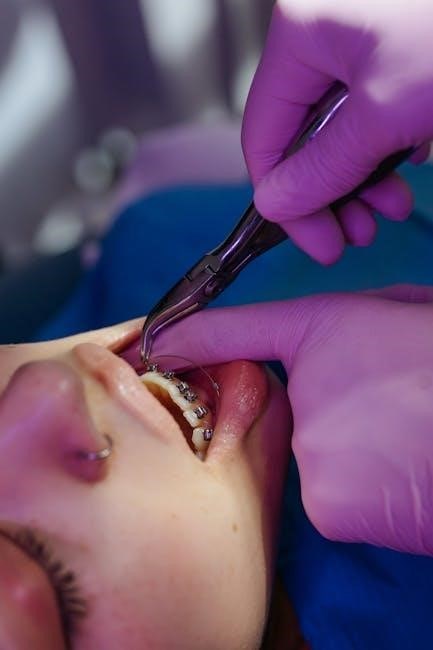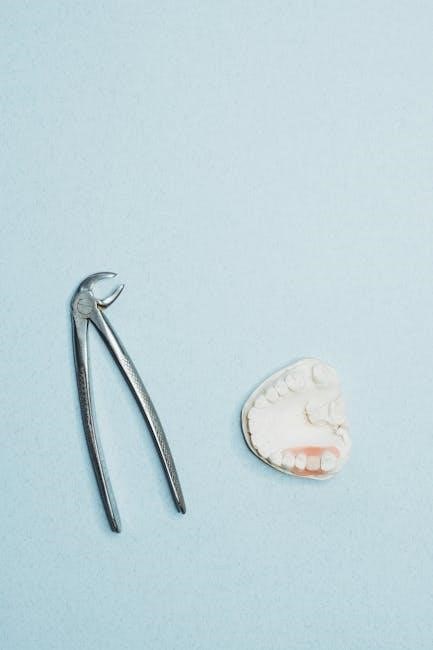Post-Op Instructions After Tooth Extraction
After tooth extraction, bite firmly on gauze for 30-45 minutes to promote clotting. Avoid rinsing, spitting, or using straws for 24 hours to protect the clot.
Immediate Post-Operative Care
Immediately after tooth extraction, it is crucial to follow specific steps to ensure proper healing. Bite firmly on the gauze pad provided for 30-45 minutes to allow a blood clot to form. Avoid dislodging the clot, as it is essential for healing. Rest quietly with your head elevated to reduce bleeding and swelling. If bleeding persists, place a clean, damp gauze over the site and bite gently for another 30 minutes. Avoid spitting, rinsing, or using straws for at least 24 hours, as these actions can dislodge the clot. Refrain from smoking or consuming alcohol during this period, as they can delay healing. If numbness or tingling occurs, it is temporary and due to the local anesthesia. Monitor the site for excessive bleeding and contact your dentist if concerns arise.
Importance of the Blood Clot
The blood clot that forms in the tooth socket after extraction is vital for the healing process. It acts as a protective barrier, preventing infection and allowing the wound to heal properly. The clot also helps in reducing bleeding and supports the growth of new tissue; If the clot is dislodged, it can lead to complications such as dry socket, a painful condition that delays recovery. Therefore, it is essential to avoid activities that might disturb the clot, such as rinsing vigorously, spitting, or using straws. Protecting the blood clot ensures a smooth and uncomplicated recovery, minimizing the risk of post-operative complications.
Managing Bleeding After Surgery
Bleeding after tooth extraction is normal and typically subsides within a few hours. To manage it, bite firmly on the gauze provided for 30-45 minutes. If bleeding persists, replace the gauze with a clean, damp one and apply pressure for another 30 minutes. Elevating your head while resting can also help reduce bleeding. Avoid strenuous activities, as they may dislodge the blood clot and worsen bleeding. If bleeding remains heavy or uncontrollable despite these measures, contact your dentist immediately. Minor oozing is normal and may continue for up to 24 hours, but excessive bleeding requires medical attention to prevent complications. Follow your dentist’s instructions closely to ensure proper healing and minimize the risk of post-operative issues.

Day 1 Recovery Guidelines
Rest is crucial on the first day. Stick to soft foods, avoid rinsing or spitting, and refrain from smoking or using straws to promote healing and prevent complications.
Biting on Gauze
Biting on gauze is essential immediately after tooth extraction to control bleeding and promote clot formation. Patients should firmly bite down on the gauze pad for 30-45 minutes without interruption. If bleeding persists, additional gauze may be placed, and the process should be repeated. The gauze should be dampened with water before use to enhance its effectiveness. It’s important to remain still and avoid talking during this time to ensure the clot adheres properly. After removing the gauze, a pinkish or blood-tinged saliva is normal, but heavy bleeding should be reported to the dentist. This step is critical for initiating the healing process and preventing complications like dry socket.
Avoiding Rinsing and Spitting
Avoiding rinsing and spitting for the first 24 hours after tooth extraction is crucial to protect the blood clot. Rinsing can dislodge the clot, leading to complications like dry socket. Gently spit only when necessary, and avoid using straws, as the suction can disrupt the healing site. Do not rinse vigorously or use mouthwash during this period. Instead, let saliva naturally cleanse the area. After 24 hours, you may start rinsing gently with warm salt water to promote healing. However, avoid forceful spitting or rinsing even then. By refraining from these actions, you help ensure the clot remains intact, reducing the risk of inflammation and infection; This care is vital for a smooth and uneventful recovery following your tooth extraction procedure.
Rest and Activity Level
Rest is essential after tooth extraction to promote healing and avoid complications; For the first 24 hours, avoid strenuous activities, bending, or lifting heavy objects, as this can dislodge the blood clot. Keep your head elevated using pillows to reduce swelling and promote clot formation. Avoid vigorous exercise or physical exertion for 48-72 hours. Light activities, such as reading or watching TV, are acceptable. Gradually resume normal activities after the first day, but avoid anything that could disrupt the healing process. By resting adequately, you support your body’s natural healing mechanisms and minimize the risk of post-operative issues. Proper rest ensures a smoother recovery and helps maintain the integrity of the extraction site.
Pain and Swelling Management
Pain and swelling are normal after tooth extraction. Use ice packs or cold compresses to reduce swelling. Take prescribed or over-the-counter pain relievers as directed.
Normal Symptoms After Extraction
After a tooth extraction, it’s common to experience bleeding, swelling, and discomfort. Mild pain, bruising, and limited jaw movement may occur. Numbness or tingling in the lips, tongue, or cheek is temporary due to anesthesia. Swelling typically peaks in the first 24-48 hours and subsides gradually. Bleeding may continue as oozing for several hours, and a blood clot forms to aid healing. These symptoms are part of the normal recovery process and usually resolve within a few days. If any of these symptoms worsen or persist, contact your dentist for guidance.
Recommended Pain Relief Strategies
Managing pain after tooth extraction is crucial for a comfortable recovery. Your dentist may prescribe pain relievers, which should be taken as directed. Over-the-counter medications like ibuprofen or acetaminophen can also help alleviate discomfort. Applying a cold compress to the affected area can reduce swelling and ease pain. Resting and avoiding strenuous activities during the first 24 hours is advised. Stick to soft foods and avoid chewing near the extraction site. If pain persists or worsens, contact your dentist for further guidance. It’s important to follow the recommended pain relief strategies to ensure proper healing and minimize discomfort.

Dietary Recommendations
Stick to soft, cold foods like yogurt, scrambled eggs, and mashed potatoes. Avoid hot, hard, or crunchy foods, alcohol, and coffee for 24-48 hours.
Soft Foods to Eat
After tooth extraction, opt for soft, non-irritating foods to avoid discomfort and promote healing. Ideal choices include yogurt, scrambled eggs, mashed potatoes, and applesauce. Cold or lukewarm foods like ice cream, pudding, and smoothies are also recommended during the first 24 hours. Stock up on soft grains such as rice, pasta, and oatmeal, which are gentle on the mouth. Avoid hot, spicy, or acidic foods that could irritate the extraction site. Soft-cooked vegetables like carrots or zucchini can be introduced after the first day, but ensure they are not too hot. Soups are also a good option, as long as they are not overly hot or chunky. Choose foods that require minimal chewing to reduce strain on the surgical area.
Foods to Avoid
During the recovery period, it’s crucial to avoid foods that could disrupt healing or irritate the extraction site. For the first 24-48 hours, avoid hot, hard, crunchy, or spicy foods, as they can dislodge the blood clot. Specific foods to avoid include nuts, chips, raw vegetables, and sharp or sticky foods like candies or caramels. Avoid consuming anything with seeds or pits, as these can get lodged in the socket. Additionally, steer clear of carbonated beverages and alcohol, as they can interfere with the healing process. Acidic foods and drinks should also be avoided to prevent irritation. It’s best to wait at least 3-5 days before gradually reintroducing harder or more textured foods. By avoiding these foods, you can help ensure proper healing and minimize the risk of complications. Stick to soft, bland, and lukewarm foods to support your recovery effectively.

Activities to Avoid
Avoid smoking, using straws, and strenuous activities for 24-48 hours. These can dislodge the blood clot, leading to complications like dry socket and delayed healing.
Smoking and Alcohol Consumption
Smoking and alcohol consumption should be avoided for at least 24-72 hours after tooth extraction. Smoking can dislodge the blood clot, leading to dry socket, and delay healing. Alcohol can interfere with clotting and interact with pain medications. Avoiding these activities ensures proper healing and prevents complications. Smoking introduces harmful chemicals that can irritate the extraction site, while alcohol can thin blood and prolong bleeding. Both habits increase the risk of infection and prolong recovery. It is recommended to refrain from smoking for at least 72 hours and avoid alcoholic beverages for 24 hours or as advised by your dentist. Adhering to these guidelines promotes a smooth and uneventful recovery process.
Using Straws
Using straws should be avoided for at least 7-10 days after tooth extraction. The suction created by drinking through a straw can dislodge the blood clot from the extraction site, leading to complications such as dry socket. Dry socket is a painful condition that delays healing and requires additional treatment. To prevent this, drink directly from a glass and avoid any activities that involve suction, such as sipping through a straw. This precaution is crucial during the initial healing phase, as the clot is vital for proper recovery. By avoiding straws, you protect the extraction site and ensure the healing process progresses smoothly. Your dentist may provide specific guidance, but generally, waiting 7-10 days before using straws is recommended to safeguard your recovery.
Oral Hygiene After Extraction
Maintain cleanliness by rinsing with warm salt water after meals. Avoid harsh mouthwashes initially. Gently clean the area with a soft toothbrush to promote healing without irritating the site.
Rinsing with Salt Water
Rinsing with warm salt water helps maintain oral hygiene and promotes healing after tooth extraction. Dissolve two teaspoons of salt in a cup of warm water and gently swish around your mouth, especially near the extraction site, after every meal and before bed. This practice begins 24 hours post-surgery, as advised by dental professionals. Avoid vigorous rinsing, as it might dislodge the protective blood clot. Continue this routine for several days to reduce the risk of infection and support the healing process. Saltwater rinses are a simple yet effective way to keep the area clean and promote recovery without causing discomfort or complications.
Gentle Mouth Cleaning
Gentle mouth cleaning is essential to maintain hygiene without disrupting the healing process. Use a soft-bristled toothbrush and mild toothpaste to clean your teeth, avoiding the extraction site. Gently rinse with warm water, but avoid vigorous movements. Do not use harsh mouthwashes or abrasive products that could irritate the area. Begin cleaning as soon as possible, but be cautious around the extraction site to prevent dislodging the blood clot. Resume normal brushing gradually, ensuring the area remains clean to prevent infection. Gentle care helps promote healing and prevents complications, such as dry socket or infection. Always follow your dentist’s specific instructions for post-operative oral hygiene to ensure a smooth recovery.

Recovery Timeline and Follow-Up
Recovery typically takes a few days to a week, with most healing occurring within 1-2 weeks. Follow-up appointments are usually scheduled within 7-14 days to monitor healing progress and remove any sutures if necessary. Attend all post-operative check-ups to ensure proper recovery and address any concerns. If unusual symptoms like increased pain, swelling, or bleeding persist, contact your dentist promptly for evaluation.
Healing Process and When to Seek Help
The healing process after tooth extraction typically progresses smoothly, with the blood clot forming in the socket to protect the bone and nerve endings. It’s crucial to allow this clot to heal undisturbed for proper recovery. However, if you notice excessive bleeding that doesn’t stop with gauze pressure, severe pain that doesn’t improve with prescribed medication, or signs of infection such as swelling, redness, or fever, seek immediate medical attention. Additionally, if you experience a bad taste or discharge from the extraction site, it could indicate a complication like dry socket, which requires professional treatment. Monitor your symptoms closely and contact your dentist if anything unusual occurs, as timely intervention can prevent serious issues and ensure a smooth recovery.

